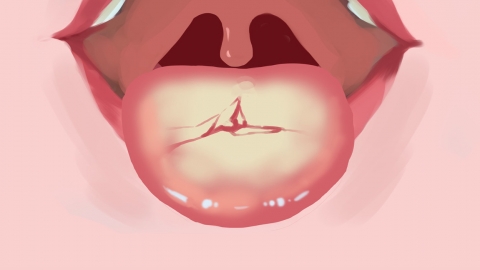What is the tongue appearance associated with damp-heat in the liver and gallbladder?
Generally, Damp-Heat in the liver and gallbladder presents typical manifestations on the tongue, primarily reflected through aspects such as tongue coating color, tongue coating texture, tongue body color, tongue body shape, and tongue surface moisture. These can serve as important references for identifying Damp-Heat in the liver and gallbladder. The specific analysis is as follows:

1. Tongue Coating Color: In individuals with Damp-Heat in the liver and gallbladder, the tongue coating is typically yellow. The depth of the yellow color correlates with the severity of the Damp-Heat. In mild cases, the tongue coating appears light yellow, while in more severe cases it becomes deep yellow or even dark yellowish-brown. The yellow color usually evenly covers the tongue surface, particularly more pronounced in the middle and root areas of the tongue, clearly distinguishing it from the normal pale white tongue coating.
2. Tongue Coating Texture: The tongue coating often appears thick and greasy, as if a layer of viscous mucus or oily substance covers the tongue surface. When gently scraped with a cotton swab, only a small amount of coating is removed, and the tongue still feels greasy afterward. In some individuals, the tongue coating may also present with granular texture, appearing coarse and difficult to remove.
3. Tongue Body Color: The tongue body itself often appears redder, especially at the tip and edges of the tongue, where the redness is more evident. This is due to internal accumulation of Damp-Heat causing significant internal heat signs, accelerating blood circulation, and resulting in fullness of the tongue's blood vessels, thus presenting a reddish appearance. In severe cases, the tongue may appear dark red.
4. Tongue Body Shape: The tongue body is often swollen and enlarged, with teeth marks possibly appearing along the edges. This is caused by Damp-Heat obstructing the flow of Qi, leading to impaired water metabolism and internal accumulation of dampness within the tongue tissue, causing swelling and enlargement of the tongue. As a result, the tongue becomes compressed by the teeth, forming teeth marks. Some individuals may also experience swelling and stiffness of the tongue body.
5. Tongue Surface Moisture: The tongue surface often appears excessively moist, even showing signs of fluid droplets forming. This is due to excessive internal Damp-Heat causing dampness to rise upward to the tongue surface, increasing the amount of fluid present. Upon touch, the tongue feels notably sticky and wet, clearly differing from a dry or normally moist tongue.
In daily health management, individuals with Damp-Heat in the liver and gallbladder can appropriately consume more foods that clear heat and resolve dampness, such as mung beans, winter melon, and coix seed. They should avoid spicy, greasy, and raw cold foods, maintain a regular lifestyle, avoid staying up late, and help alleviate the Damp-Heat condition.




